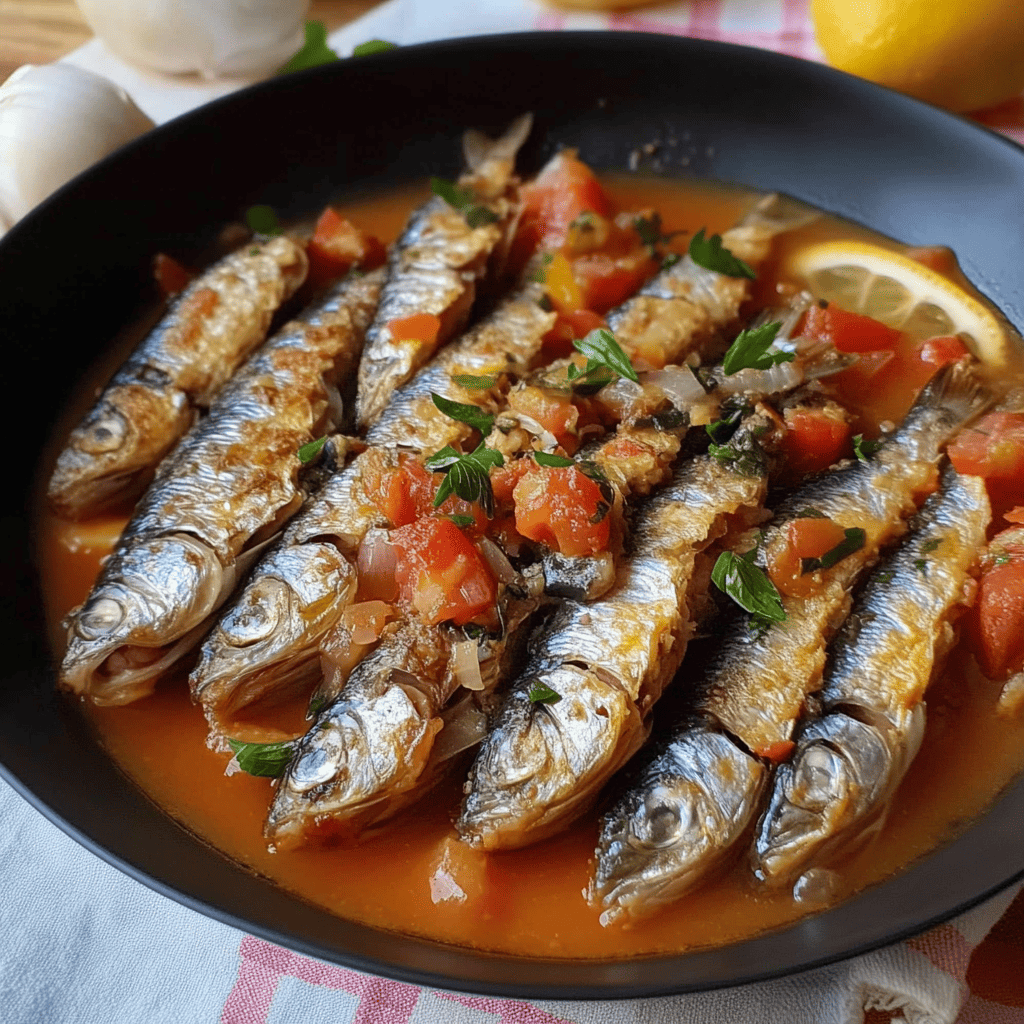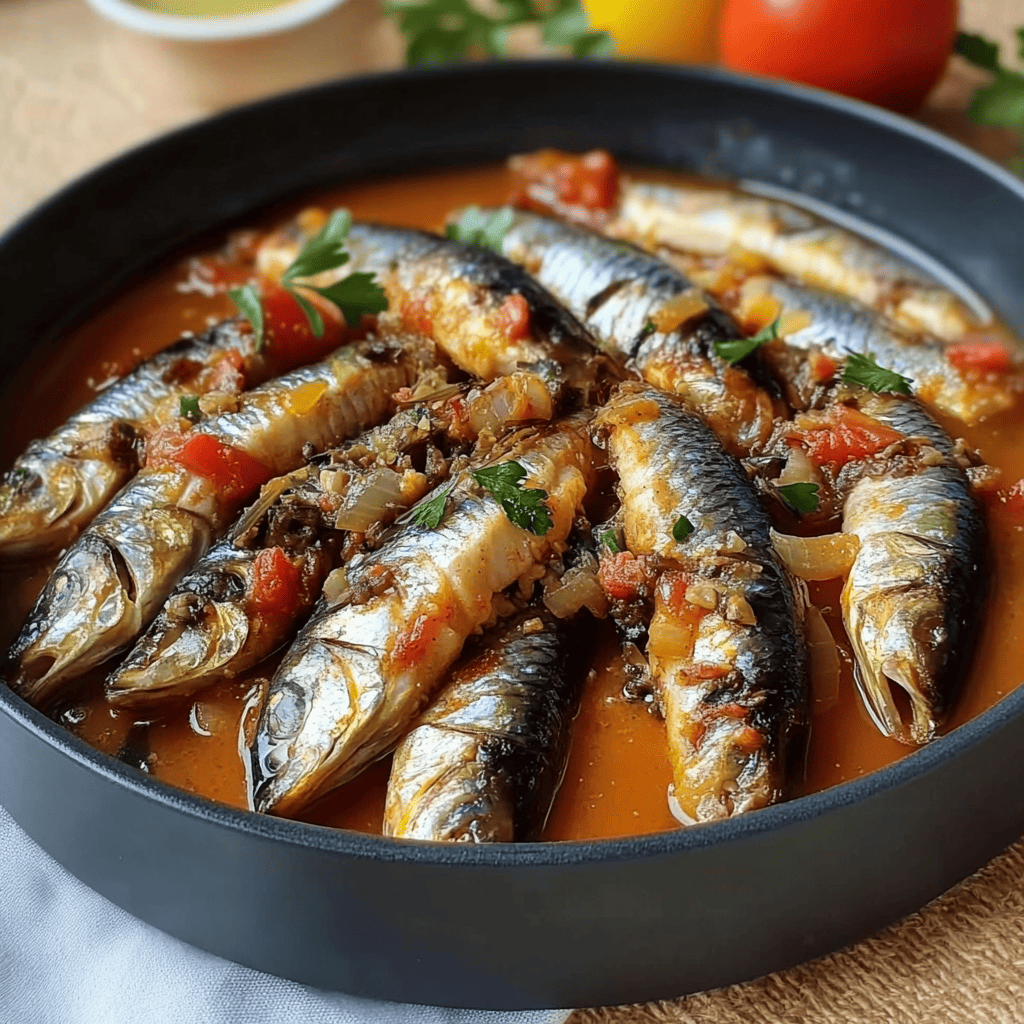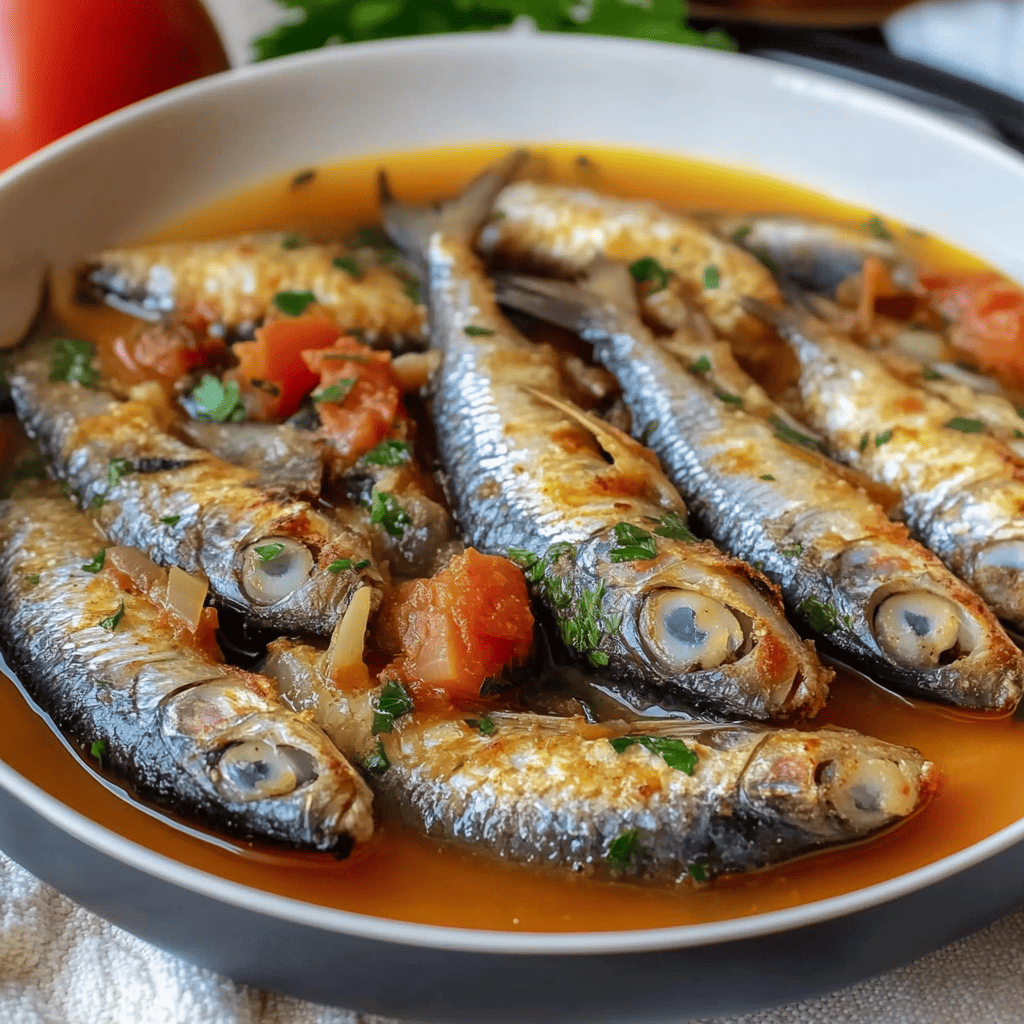Sardines in Sauce: A Mediterranean Treasure Full of Flavor and Tradition
Introduction: The Simple Charm of Bluefish at its Best
Sardines in sauce, as presented in the image, are much more than a simple dish: they are a window into the rich and diverse Mediterranean cuisine, where the freshness of the sea meets the warmth of the land’s ingredients. This rustic and delicious stew celebrates the sardine, a humble but extraordinarily nutritious blue fish, transforming it into a succulent and aromatic preparation. Slowly cooked in a sauce that blends the sweetness of onion, the pungent aroma of garlic, the earthy nuance of tomato, and the distinctive touch of bay leaf, these sardines offer an explosion of flavor that warms the soul. It’s a dish that evokes the simplicity of home cooking, but with a surprising depth of flavor. Ideal to enjoy with a hearty piece of rustic bread, soaking in the delicious sauce, or as part of a tapas menu, sardines in sauce represent the essence of a cuisine that values fresh ingredients and traditional techniques. Their ease of preparation belies the complexity of their flavor profile, making them a perfect choice for a nutritious and memorable meal.
Detailed History: A Culinary Journey from Antiquity to Today’s Table
The history of sardines in sauce is as old as fishing and trade in the Mediterranean. Sardines, a type of pelagic fish abundant off the coasts of Europe and Africa, have been a fundamental food source for coastal communities since ancient times. Their name comes from the island of Sardinia , where they were believed to be particularly abundant. Given their availability and nutritional value, sardines were consumed fresh, salted, or in oil, methods that allowed them to be preserved long before the invention of modern refrigeration.
The preparation of fish in sauces based on tomato, onion, garlic, and herbs has deep roots in Mediterranean cuisine, particularly in Spain, Italy, Portugal, and North Africa. These cultures have developed a wide range of stews and marinades where fish is slowly cooked with vegetables and aromatic seasonings. The sauce acts not only as a cooking medium but also as a natural preservative and flavor enhancer. The use of ingredients such as onion, garlic, and bay leaves in fish stews is an ancient practice, dating back to Roman and medieval times, when these spices were common and accessible.
In Spain, for example, pickled sardines are very popular. This preparation involves cooking the fish in a mixture of oil, vinegar, garlic, bay leaves, and paprika, allowing the fish to retain its unique sweet and sour flavor. The recipe for sardines in sauce, like the one pictured, is more similar to a stew or “a la marinera,” where the tomato and vegetables provide a richer, denser base, without the overpowering acidity of vinegar in a pickle. This type of preparation has been passed down from generation to generation, adapting to local ingredients and family preferences.
For centuries, sardines have been a staple food for the working classes, valued for their affordable price and high nutritional content. However, over time, their culinary appreciation has grown, and they are now enjoyed in a variety of forms, from grilled to sophisticated stews. Sardines in sauce encapsulate this evolution, maintaining the simplicity of their origins while offering a dish that is simultaneously nutritious, flavorful, and deeply rooted in Mediterranean culinary tradition. They represent a legacy of culinary ingenuity, where modest ingredients are transformed into a hearty and delicious meal, celebrating the bounty of the sea and the richness of local flavors.
More Details of History: Techniques, Traditions and the Role of Bluefish
The slow-cooking technique in a stew, as seen with sardines in sauce, is a culinary practice that has endured through the centuries due to its effectiveness in tenderizing foods and allowing flavors to blend and deepen. In the case of sardines, this gentle cooking helps the bones soften and become edible, increasing their calcium content. The fact that whole sardines are visible in the pan suggests a traditional preparation, where the goal is to preserve the integrity of the fish.
The use of a cast iron skillet, like the one pictured, is another nod to culinary tradition. Cast iron skillets are valued for their ability to retain and distribute heat evenly, which is ideal for slow cooking and stews, ensuring that the dish cooks consistently and develops a layer of flavor (“base”) on the bottom.
The vegetables visible in the sauce—julienned onions, sliced carrots, and whole garlic cloves—not only add texture and flavor but also reflect the Mediterranean diet, rich in fresh vegetables. The bay leaf, visible in the sauce, is a classic aromatic herb in stews and casseroles, known for imparting a slightly bitter and sweet flavor that enhances the profile of the fish.
Furthermore, cooking sardines in sauce or escabeche has historically been associated with preservation. The cooking process in an acidic base (such as vinegar in escabeche) or in a sauce rich in tomato and oil allowed the fish to prolong its shelf life in times when refrigeration was limited or nonexistent. This made sardines not only a tasty food, but also a vital food source for transportation or storage.
Today, sardines remain a valued food for their sustainability and nutritional richness, especially in omega-3 fatty acids. This dish, therefore, is not only a culinary delight, but also an example of how traditional cuisine has successfully combined flavor, nutrition, and convenience throughout history.

Ingredients: A Simple Cast for Deep Flavor
- Fresh Sardines: Approximately 8-10 medium sardines, cleaned (without scales or guts), with head and tail if desired for a more traditional presentation.
- Onion: 1 large onion, cut into thin julienne strips or strips.
- Carrot: 1-2 medium carrots, peeled and cut into thin slices or small sticks.
- Garlic: 3-4 cloves of garlic, whole and lightly crushed or sliced.
- Tomato: 1 can (400g) of crushed tomatoes or 2-3 grated fresh ripe tomatoes (or concentrated tomato paste for more color and flavor).
- Bay leaf: 1-2 dried leaves.
- Extra virgin olive oil: Enough for the sauce and to lightly coat the sardines.
- Salt and black pepper: To taste.
- Dry white wine: ½ cup (optional, to deglaze and add flavor).
- Water or fish stock: ½ – 1 cup (to adjust the consistency of the sauce).
- Sweet or spicy paprika: 1 teaspoon (optional, for color and flavor).
- Fresh parsley: Chopped, for garnish (optional).
Detailed Preparation: Cooking with Love and Patience
This detailed process will guide you to achieving the perfect sardines in sauce, with the consistency and flavor seen in the image:
Step 1: Initial Preparation of the Sardines and Vegetables
- Cleaning the Sardines: If the sardines are not already clean, remove the scales by gently scraping them with a knife or brush under running water. Make a cut in the belly to extract the viscera. You can choose to leave the head and tail, as shown in the image, or remove them as you prefer. Wash the sardines well and dry them carefully with kitchen paper to avoid splashing when frying.
- Cut the Vegetables: Peel the onion and cut it into thin julienne strips or strips. Peel the carrots and cut them into thin slices or small, even sticks. Peel the garlic cloves and either leave them whole or lightly crush them to release their aroma, or slice them.
Step 2: Sofrito Base of the Sauce
- Heat the Oil: In a heavy-bottomed skillet (ideally cast iron, like the one pictured) over medium heat, add a good splash of extra virgin olive oil (about 3-4 tablespoons).
- Sauté the Aromatics: When the oil is hot, add the whole (or sliced) garlic cloves and the bay leaf. Sauté for 1-2 minutes until the garlic begins to lightly brown and releases its aroma. Remove the garlic if you don’t want it to brown too much and add it back later.
- Add Onion and Carrot: Add the julienned onion and carrots to the pan. Sauté over medium-low heat for 8-10 minutes, or until the onion is translucent and the carrot is slightly tender. Stir occasionally to prevent sticking.
- Optional – Paprika: If using paprika, add it at this point and sauté for just 30 seconds, stirring constantly to prevent it from burning, as burnt paprika is bitter.
Step 3: Make the Sauce
- Deglaze (Optional): If using white wine, increase the heat and pour in 1/2 cup of white wine. Let it come to a boil and let the alcohol evaporate (about 2-3 minutes), scraping the bottom of the pan with a spatula to release the caramelized juices.
- Add Tomato and Liquid: Add the crushed tomatoes (or grated tomatoes/diluted tomato paste). Stir well and cook over medium heat for 5-7 minutes, until the sauce thickens slightly and the flavors combine. If the sauce is too thick, add a little water or fish stock (1/4 cup).
- Season the Sauce: Season the sauce to taste. Taste and adjust the seasoning.
Step 4: Cook the Sardines
- Add the Sardines: Carefully place the cleaned and dried sardines on top of the sauce in the pan. If you previously removed the garlic, this is the time to add it back in.
- Slow Cook: Reduce the heat to low, cover the pan with a lid, and let the sardines simmer for about 15-20 minutes. The exact time will depend on the size of the sardines. The goal is for them to cook gently in the sauce, absorbing all the flavors without falling apart.
- Turn Carefully (Optional): If the sardines are large and the sauce doesn’t cover them completely, you can turn them very carefully halfway through cooking (after about 10 minutes) so they cook evenly. However, in many stews of this type, they cook only on one side if they’re fully submerged.
- Cooking Test: Sardines are ready when their meat is white and tender, and the larger bones are softened.
Step 5: Rest and Service
- Rest: Once cooked, remove the pan from the heat. If possible, let the sardines rest in the sauce for 5-10 minutes with the lid on. This allows the flavors to settle and the sauce to thicken slightly.
- Serving: Serve the sardines hot straight from the pan, accompanied by their delicious sauce.
- Garnish (Optional): Sprinkle with chopped fresh parsley before serving, if desired.
Estimated Preparation Time
- Active Preparation (Cleaning and Cutting): 15-20 minutes
- Sofrito and Sauce Preparation: 15-20 minutes
- Cooking Sardines: 15-20 minutes
- Estimated Total Time: 45 – 60 minutes
Additional Tips for Perfect Sardines
- Freshness is Key: The quality of fresh sardines is paramount. Look for sardines with bright eyes, silvery skin, and firm flesh. The smell should be of the sea, not “fishy.”
- Don’t Overcook: Sardines cook quickly. Overcooking will dry them out and make them less palatable. Cook them just until the meat is opaque.
- Adjust the Thickness of Vegetables: Slice the onion and carrot evenly so they cook at the same rate.
- Suitable Pan: A wide, heavy-bottomed pan, preferably cast iron, is ideal for distributing heat evenly and preventing the fish from sticking or falling apart.
- Resting the Sauce: If you have time, you can prepare the sauce in advance. The flavors of the stews usually improve the next day.
- Herb Variations: In addition to bay leaves, you can add other Mediterranean herbs such as oregano, thyme, or a sprig of rosemary to the sauce.
- Spicy Touch: If you like spicy food, you can add a pinch of red chili flakes to the sofrito.
- Serve with Bread: A good rustic bread is the ideal companion for dipping in the delicious sauce.

Frequently Asked Questions and Clear Answers
- Do I need to remove the bones from sardines? It’s not strictly necessary, especially if they’re small and cooked slowly. The bones soften greatly and are safe to eat, providing calcium. However, if you prefer, you can remove the bones after cooking, or ask your fishmonger to do it for you.
- Can I use canned sardines for this recipe? Although the recipe is designed for fresh sardines, you could use canned sardines in oil or plain, but the texture and flavor will be different. In that case, you would add them near the end of the sauce’s cooking time, just to warm them through and infuse them with flavor.
- Can I make this dish without tomatoes? Yes, you could make a “white” or light pickled version without tomatoes, although the color and flavor would be different. The picture clearly shows a tomato base because of the reddish color.
- How do I know if my sardines are fresh? Fresh sardines have clear, bright eyes, glossy, shiny skin, and a fresh, sea smell, not a “strong fishy” one. The meat should be firm to the touch.
- Can I cook this dish in the oven? Yes, once the sauce is made, you can place the sardines in a baking dish, pour the sauce over them, and bake at 180°C (350°F) for about 15-20 minutes, or until cooked through.
Texture and Flavor: A Moist and Aromatic Symphony
- Texture: Sardines in sauce are characterized by a juicy, tender texture that melts gently in the mouth. Slow cooking in the sauce keeps them moist and prevents them from drying out. The vegetables (onion and carrot) provide a soft, slightly chewy texture , while whole or sliced garlic cloves become tender and almost creamy. The sauce itself has a rich, slightly thickened consistency , perfect for dipping.
- Flavor: The flavor is a complex harmony of marine umami and earthy sweetness . The intense flavor of the sardines, characteristic of oily fish, is balanced and complemented by the caramelized sweetness of the onion, the slightly earthy flavor of the carrot, and the spicy, aromatic touch of garlic. The tomato contributes a gentle acidity and concentrated sweetness, forming the base of the sauce. The bay leaf imparts a subtle yet distinctive herbaceous aroma. Using paprika adds a smoky or sweet note. The result is a deep, comforting flavor full of Mediterranean nuances , inviting you to continue eating.
Consumption Context: The Versatile Delight of Mediterranean Cuisine
Sardines in sauce are an incredibly versatile dish that adapts to various occasions and ways of eating:
- Main Course: They are a substantial and complete main course, especially if served with a side dish that absorbs the sauce well.
- Perfect Accompaniment:
- Rustic Bread: Ideal for dipping in the rich and tasty sauce.
- White Rice: The rice absorbs the sauce and complements the fish.
- Boiled or Roasted Potatoes: Perfect for a more complete meal.
- Fresh Salad: A light green salad can balance the richness of the stew.
- Tapas and Appetizers: These can be served in small bowls as part of a tapas table, accompanied by toast or crackers.
- Home Cooking: A comforting and nutritious dish for everyday life.
- Summer and Winter: Although sardines are in season in summer, this type of stew is enjoyed year-round, adapting to the seasons due to its warmth.
- Make-Ahead Food: Sauces, and even the entire dish, improve with time, so they can be prepared in advance and reheated gently.
Visual Appearance: A Culinary Work of Art in the Pan
The image of sardines in sauce is extremely attractive and professional, highlighting several key visual elements:
- Cast Iron Skillet Presentation: The dish is presented directly in a dark cast iron skillet, giving it a rustic, authentic, and homey look. The skillet also suggests traditional cooking and maintains heat.
- Whole Golden Sardines: The sardines are arranged neatly in the sauce, their silvery, lightly browned skin indicating they’ve been cooked to perfection and retain their integrity. The fins and tails are visible, accentuating their authenticity.
- Rich and Vibrant Sauce: The sauce has a deep reddish-orange color, suggesting a concentrated tomato base and possibly paprika. Its consistency is juicy and appetizing, partially coating the sardines.
- Visible Vegetables: Julienne onion pieces, diced or sliced carrots, and whole garlic cloves are clearly visible in the sauce, adding texture, color, and the promise of fresh vegetable flavors.
- Bay Leaf: The presence of a visible bay leaf reinforces the aromatic and traditional character of the stew.
- Color Contrast: The combination of the silver tones of the sardines, the red-orange of the sauce, and the colors of the vegetables (white from the onion, orange from the carrot) creates a visually appealing and appetizing palette.
- Soft Lighting: The lighting used enhances the depth of colors and textures, making the dish look fresh and ready to be enjoyed.
Fun Facts: Fascinating Facts about Sardines and Their Preparation
- Bluefish and Sustainability: Sardines are an excellent example of sustainable bluefish, as they reproduce quickly and their populations are usually abundant.
- Sardine Season: Although they can be found year-round, peak season for fresh sardines is typically during the summer months, when they have a higher fat content and, therefore, a more intense flavor.
- Benefits of Cooked Tomatoes: Cooking tomatoes, as in this sauce, increases the bioavailability of lycopene, a powerful antioxidant.
- Garlic in Pickles: Garlic has been a fundamental ingredient in pickles not only for its flavor, but also for its antimicrobial properties that aid in preservation.
- Bay Leaf and Digestion: In addition to its aroma, bay leaf has traditionally been used to aid in the digestion of heavier meals.
Nutritional Value (Estimated per Serving)
The nutritional value of sardines in sauce is remarkable, making them a very complete and healthy dish. One serving (approximately 2-3 sardines with their sauce):
- Calories: 200-300 kcal (depending on the size of the sardines and the amount of oil/sauce).
- Protein: 20-25g (high protein content of sardines).
- Total Fat: 12-20g (mainly healthy Omega-3 fats from fish and olive oil).
- Omega-3: Very high content of EPA and DHA fatty acids, essential for cardiovascular and brain health.
- Carbohydrates: 5-10g (from vegetables and tomato).
- Fiber: 2-4g (from vegetables).
- Cholesterol: 50-70mg.
- Calcium: 150-250mg (especially if the soft bones are eaten).
- Vitamin D: 8-12 mcg (sardines are one of the few natural dietary sources).
- Vitamin B12: Very high content.
- Other Minerals: Phosphorus, selenium, iodine, iron and zinc.
Additional Benefits and Interesting Facts
- Cardiovascular Health: The high Omega-3 content in sardines helps reduce bad cholesterol and triglyceride levels, improving heart health.
- Bone Health: Sardines, especially when eaten with their small bones, are an exceptional source of calcium and vitamin D, essential for bone density and the prevention of osteoporosis.
- Antioxidants: The combination of oily fish, tomato, and extra virgin olive oil provides a powerful source of antioxidants.
- Powerful Flavor: Despite its simplicity, the umami flavor of sardines cooked in this sauce is surprisingly rich and satisfying.
- Affordable and Accessible: Sardines tend to be a relatively inexpensive and easy-to-find fish, making them a healthy and affordable option.
- Culinary Versatility: Although delicious in sauce, sardines are also enjoyed grilled, pickled, fried, or in salads.
- Promote Brain Health: Omega-3s are crucial for brain development and function.
Other Information
- Allergies: This dish contains fish. It is gluten and dairy free unless additional ingredients are added.
- Advance Preparation: The sauce can be prepared in advance, and even the entire dish tends to improve in flavor the next day, allowing the ingredients to settle.
- Pairing: Pairs well with dry, crisp white wines, or even a light, cold beer.

Conclusion: A Bite of the Mediterranean Sea in Every Spoonful
Sardines in sauce are a testament to the beauty of cuisine that values fresh ingredients and patience. This dish, as illustrated, is not just a meal, but a sensory experience that transports you to the shores of the Mediterranean. With their deep, comforting flavor, juicy texture, and impressive nutritional profile, sardines in sauce are a clever and delicious culinary choice. Whether enjoyed with crusty bread to soak up every drop of their rich sauce or as a healthy main dish, these sardines offer a celebration of flavor and tradition, a reminder that life’s greatest pleasures often lie in the simplicity and authenticity of ingredients. Dare to prepare this culinary gem and discover why sardines, humble in appearance, are truly a treasure of the sea.

